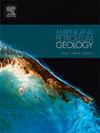新西兰塔拉纳基盆地的有机地球化学和一维盆地模型:新生代石油和凝析油储层三角洲源岩的含义
IF 3.7
2区 地球科学
Q1 GEOSCIENCES, MULTIDISCIPLINARY
引用次数: 0
摘要
新西兰塔拉纳基盆地是一个石油和凝析油勘探活跃的地区。这项研究的重点是将地球化学特征和一维盆地模型与塔拉纳基盆地五十七口油井的石油和凝析油数据相结合,研究晚白垩世至中新世的源岩系统。地球化学研究显示,石油和凝析油样本来自富含粘土的源岩,其中含有混合有机质,并有大量陆地有机质输入。这些源岩沉积于缺氧条件下的河口至河口三角洲环境中。石油和凝析油样本中都含有齐墩果烷,这表明这些源岩含有大量陆地成分,沉积于晚白垩世至新生代。利用各种生物标志物代用指标、石油-源岩相关性以及一维盆地建模显示,石油和凝析油主要来自不同成熟阶段的晚白垩世拉科皮地层和古新世法雷韦尔地层。石油是在石油峰值成熟窗口内产生的,而凝析油则主要是在天然气产生窗口内源岩中石油二次裂解产生的。这一发现与一维盆地建模结果一致。模型显示,古新世法雷韦尔源岩已达到初级生油阶段(0.55-0.95 Easy %Ro),是新生代储层岩石中大部分已发现石油的来源。同时,晚白垩世的 Rakopi 源岩达到了产气窗口,其玻璃光泽反射率超过 1.30 Easy %Ro,显示出更大的产气潜力。本文章由计算机程序翻译,如有差异,请以英文原文为准。
Organic geochemistry and 1D-basin modeling in the Taranaki Basin, New Zealand: Implications for deltaic-source rocks of the cenozoic oil and condensate reservoirs
The Taranaki Basin in New Zealand is an area of active exploration for oil and condensate. This research focuses on integrating geochemical characteristics and 1-D basin modeling to Late Cretaceous to Miocene source rock systems, along with oil and condensate data from fifty-seven wells in the Taranaki Basin. The geochemical study reveals that the oil and condensate samples were generated from clay-rich source rocks, containing mixed organic matter, with large amounts of terrestrial organic matter input. These source rocks were deposited in fluvial to fluvio-deltaic environments under oxic conditions. The presence of oleanane in both oil and condensate samples suggests that the source rocks had a significant terrestrial component and deposited during the Late Cretaceous to Cenozoic. Using various biomarker proxies, oil-source rock correlation along with 1-D basin modeling revealed that the oil and condensate were mainly derived from the Late Cretaceous Rakopi and Paleocene Farewell formations at different maturity stages. The oils were generated within the peak-mature oil window, while the condensates primarily resulted from the secondary cracking of oil taking place in the source rock within the gas generation window. This finding is consistent with the 1-D basin modeling results. The model shows that the Paleocene Farewell source rock has achieved the primary stage of oil generation (0.55–0.95 Easy %Ro), contributing to most of the discovered oils in the Cenozoic reservoir rocks. Meanwhile, the Late Cretaceous Rakopi source rock reached the gas window with a higher vitrinite reflectance of more than 1.30 Easy %Ro, indicating greater gas generation potential.
求助全文
通过发布文献求助,成功后即可免费获取论文全文。
去求助
来源期刊

Marine and Petroleum Geology
地学-地球科学综合
CiteScore
8.80
自引率
14.30%
发文量
475
审稿时长
63 days
期刊介绍:
Marine and Petroleum Geology is the pre-eminent international forum for the exchange of multidisciplinary concepts, interpretations and techniques for all concerned with marine and petroleum geology in industry, government and academia. Rapid bimonthly publication allows early communications of papers or short communications to the geoscience community.
Marine and Petroleum Geology is essential reading for geologists, geophysicists and explorationists in industry, government and academia working in the following areas: marine geology; basin analysis and evaluation; organic geochemistry; reserve/resource estimation; seismic stratigraphy; thermal models of basic evolution; sedimentary geology; continental margins; geophysical interpretation; structural geology/tectonics; formation evaluation techniques; well logging.
 求助内容:
求助内容: 应助结果提醒方式:
应助结果提醒方式:


